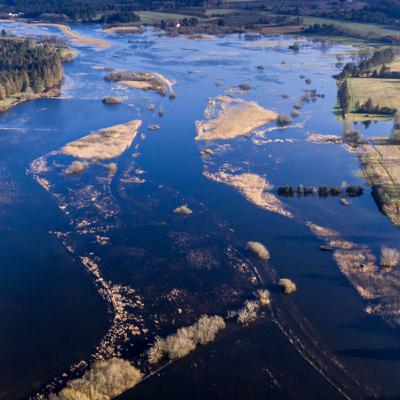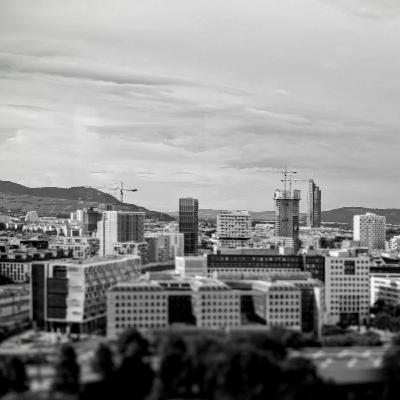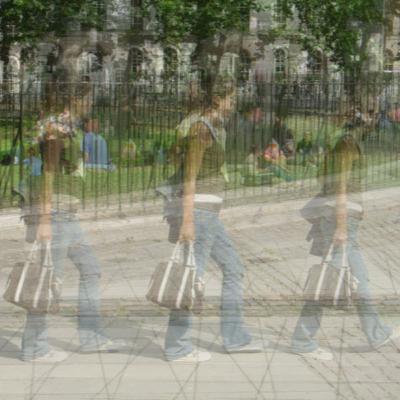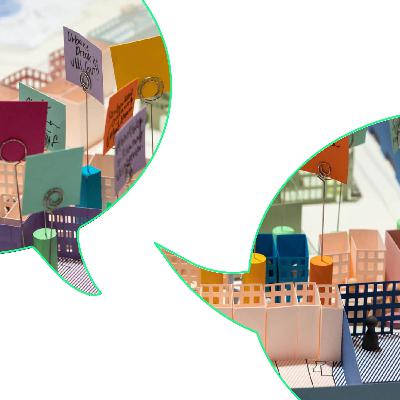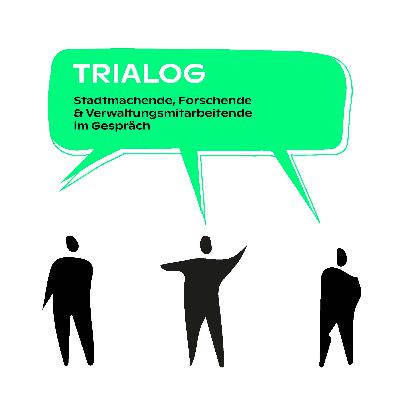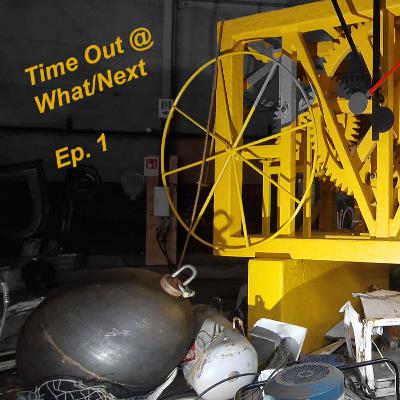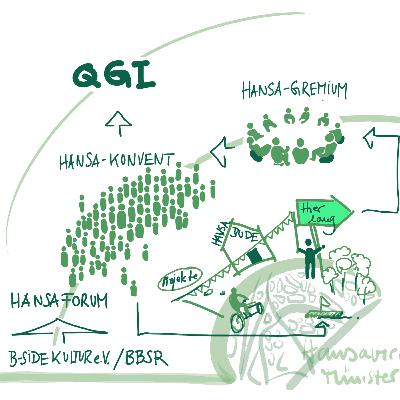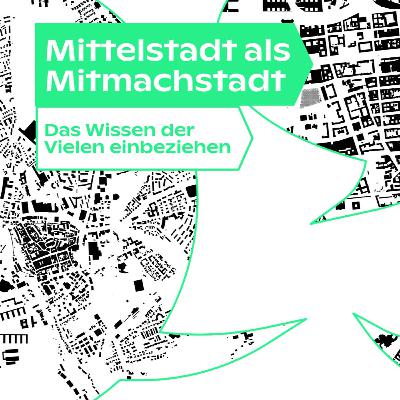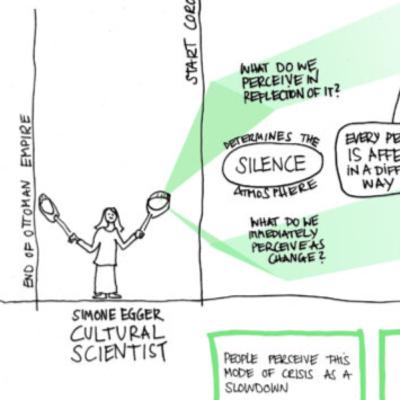Discover What/Next
What/Next

What/Next
Author: Lehrstuhl für Planungstheorie
Subscribed: 3Played: 77Subscribe
Share
© Lehrstuhl für Planungstheorie
Description
What/Next ist der Blog zur Fachzeitschrift Planung neu denken. Die Zeitschrift und der Blog werden heraus-gegeben vom Lehrstuhl für Planungstheorie und Stadtentwicklung der RWTH Aachen University.
What/Next entsteht in einem Netzwerk aus Fachleuten aus Wissenschaft und Praxis. Der Blog ist offen für Mitwirkende und Beitragende aus verschiedenen Disziplinen, Institutionen und Ländern.
What/Next entsteht in einem Netzwerk aus Fachleuten aus Wissenschaft und Praxis. Der Blog ist offen für Mitwirkende und Beitragende aus verschiedenen Disziplinen, Institutionen und Ländern.
43 Episodes
Reverse
Even when our intentions are not to seek out time as a topic of contemplation or in the case of this episode, conflict, it is at the heart of how communities make sense of the changes in their surroundings. Through this fifth episode, Miriam Jensen shares her experiences in becoming familiar with and articulating attunement as a key capacity to reconciling and responding to the environmental changes of the Danish river system of Gudenåen. While she speaks about the research that informed her doctoral dissertation, she is also reporting from on the ground experiences in participatory processes and events. In unpacking the challenges of temporal conflicts that different people face in adapting to climate change and evolving fluvial dynamics, she develops new participatory tools to help people better communicate with each other about the temporal issues at the heart of community conflicts. On this journey, she also responds to questions on the other thinkers who have affected her thinking or continue to inspire her to explore concepts such as critical horology, temporal literacy, and power chronography.Selbst wenn es nicht unsere Absicht ist, Zeit als Thema derKontemplation oder, wie in dieser Folge, als Konflikt zu betrachten, steht sie doch im Mittelpunkt dessen, wie Gemeinschaften Veränderungen in ihrer Umgebung verstehen. In dieser fünften Folge berichtet Miriam Jensen von ihren Erfahrungen und davon, wie sie sich mit der Fähigkeit der Einstimmung vertraut gemacht hat. Sie betrachtet diese Fähigkeit als Schlüsselkompetenz für die Bewältigung und Reaktion auf die Umweltveränderungen des dänischen Flusssystems Gudenåen. Sie spricht über die Forschung, die in ihre Doktorarbeit eingeflossen ist, und berichtet auch von ihren praktischen Erfahrungen mit partizipativen Prozessen und Veranstaltungen. Indem sie die Herausforderungen zeitlicher Konflikte aufzeigt, mit denen Menschen bei der Anpassung an den Klimawandel und die sich verändernde Flussdynamik konfrontiert sind, entwickelt sie neue partizipative Instrumente. Diese sollen den Menschen dabei helfen, besser über die zeitlichen Fragen zu kommunizieren, die im Mittelpunkt von Konflikten in Gemeinschaften stehen. Auf dieser Reise beantwortet sie auch Fragen zu anderen Denkern, die ihr Denken beeinflusst haben oder sie weiterhin inspirieren, Konzepte wie kritische Horologie, zeitliche Kompetenz und Machtchronografie zu erforschen.You can find the blog What/Next at www.planung-neu-denken.deSound pack credits: josefpres (https://freesound.org/people/josefpres/ )You can find this pack online at: https://freesound.org/people/josefpres/packs/36680/
In the future-oriented discipline of urban planning, the influence of the past on current decisions is chronically underrepresented. Yet, time plays a key role. The analysis of social phenomena and their transformation provides a structural perspective on urban space in temporal terms. There is a strong connection between today’s approach to planning and the evolution of planning as a discipline, and this connection influences our decisions for the future. In this episode, Johannes Suitner introduces us to his research on Vienna’s planning history to offer a temporal perspective of the planning phases of the city and how they brought to what it is today.In der zukunftsorientierten Disziplin der Stadtplanung wird der Einfluss der Vergangenheit auf aktuelle Entscheidungen chronisch unterrepräsentiert. Dabei spielt Zeit eine zentrale Rolle. Die Analyse sozialer Phänomene und ihrer Transformation eröffnet eine strukturelle Perspektive auf den urbanen Raum in zeitlicher Hinsicht. Es besteht ein enger Zusammenhang zwischen dem heutigen Planungsverständnis und der historischen Entwicklung des Fachs – ein Zusammenhang, der unsere Entscheidungen für die Zukunft maßgeblich beeinflusst. In dieser Episode gibt uns Johannes Suitner Einblick in seine Forschung zur Planungsgeschichte Wiens. Er zeigt den Zeitverlauf der Planungsphasen der Stadt und wie sie das heutige Wien geprägt haben.You can find the blog What/Next at www.planung-neu-denken.deSound pack credits: josefpres (https://freesound.org/people/josefpres/ )You can find this pack online at: https://freesound.org/people/josefpres/packs/36680/
Informed by multiple disciplinary debates including critical theory, relativity theory and quantum physics, and musicology, Temporal Urban Design is a comprehensive new theory and methodological approach to the aesthetics of time and rhythm in the city. In this third episode of Time/Out, Filipa Matos Wunderlich shares her path to conceptualizing place-temporality and learning how to map and represent the performative aesthetic of time through rhythm in different built environments. Her thinking informs her new book published at the start of 2024, which invites urban designers and planners to think differently about urban places from a temporal perspective and refreshes the way we think about urban design and widens the framework for place design practice. Overall, it anchors the conversation on place-time, rhythm and rhythmanalysis, and offers urban designers a conceptual, analytical and practice framework. Finally, it assists with ways to communicate with others on time, and design for temporality and rhythm in urban space.Gestützt auf interdisziplinäre Diskurse aus der Kritischen Theorie, der Relativitäts- und Quantenphysik sowie der Musikwissenschaft, stellt Temporal Urban Design eine umfassende neue Theorie und methodische Herangehensweise an die Ästhetik von Zeit und Rhythmus in der Stadt dar. In dieser dritten Episode von Time/Out berichtet Filipa Matos Wunderlich von ihrem Weg zur Konzeptualisierung von Ortszeitlichkeit und davon, wie sie lernte, die performative Ästhetik von Zeit durch Rhythmus in unterschiedlichen gebauten Umgebungen zu kartieren und darzustellen. Ihre Überlegungen fließen in ihr neues Buch ein, das Anfang 2024 erschienen ist. Es lädt Stadtgestaltende und Planende dazu ein, urbane Orte aus einer zeitlichen Perspektive neu zu denken, und verleiht dem Urban Design frische Impulse, indem es den Rahmen für ortsbezogene Gestaltungspraxis erweitert. Insgesamt verankert es das Gespräch um Ort-Zeit, Rhythmus und Rhythmusanalyse und bietet Stadtgestaltenden ein konzeptuelles, analytisches und praxisorientiertes Rahmenwerk – als Unterstützung für die Kommunikation über Zeit sowie für die Gestaltung von Zeitlichkeit und Rhythmus im urbanen Raum.You can find the blog What/Next at www.planung-neu-denken.deSound pack credits: josefpres (https://freesound.org/people/josefpres/ )You can find this pack online at: https://freesound.org/people/josefpres/packs/36680/
In order to initiate and implement conversion on a much larger scale, we need a change in our current culture - in planning, in building, and also in the way we use, think about, and imagine space. In this discussion we continue the debate on planning cultures of conversion. University and institutional research meets practice. We are building on the impulses and discussions of our jointly organized symposium at tu! Hambach 2024, which we organized together. We were on site in a region undergoing major restructuring: the Rhenish lignite mining area. Our event took place in the abandoned village of Morschenich-Alt, now Bürgerwald. This village is facing a far-reaching conversion process in the coming years. And even beyond the specific background of the abandonment of lignite mining, there are many reasons to take a closer look at the existing material, social and cultural resources in the existing buildings and settlement areas and to make use of them.Um Umbau in viel größerem Umfang in Gang zu setzen und umzusetzen, benötigen wir eine Veränderung unserer aktuellen Kultur – im Planen, im Bauen und auch in unserer Art und Weise, wie wir Räume nutzen, denken und imaginieren. In diesem Gespräch setzen wir die Diskussion zu Planungskulturen des Umbauens fort. Universitäre und institutionelle Forschung treffen auf die Praxis. Wir knüpfen an die Impulse und Diskussionen im Rahmen unseres gemeinsam organisierten Symposiums auf der tu! Hambach 2024 an. Dabei waren wir vor Ort in einer Region, die stark im Umbau ist: das Rheinische Braunkohlerevier. Unsere Veranstaltung fand im leergezogenen Dorf Morschenich-Alt, heute Bürgerwald, statt. Dieses Dorf hat in den kommenden Jahren einen weitreichenden Umbauprozess vor sich. Und auch jenseits der besonderen Kulisse des Braunkohleausstiegs gibt es viele Anlässe, die bestehenden materiellen wie auch sozialen und kulturellen Ressourcen im Gebäudebestand und in bestehenden Siedlungsgebieten noch stärker in den Blick zu nehmen und zu nutzen.You can find the blog What/Next at www.planung-neu-denken.deMusic: Elephants on Parade by Podington Bear. Attribution-NonCommercial 3.0 International License
There is currently a lot of discussion about conversion (culture), building and spatial change. There are many reasons for turning to and using existing material as well as social and cultural resources in existing buildings and settlements. These include the ongoing consumption of resources, the release of CO2 and the production of waste in the construction industry, the unchecked consumption of land in the development of settlements and infrastructure, and the complex forms of structural economic, social, and cultural change in urban and rural areas. The preoccupation with existing buildings is not new. A good 50 years ago, it was decisively initiated by urban development funding in Germany, the European Year of Monument Protection and a few years later by the IBA-Altbau in Berlin. The transformation in the existing built and lived city continues unabated today and is being given new impetus by a series of structural breaks and crises. These include vacancies as well as the need for renewal due to changing economic, social, or climatic conditions. In the conversation with Peter Köddermann, Stine Kolbert und Mario Tvrtković we discuss how reconstruction and redevelopment can actually be initiated, designed and implemented under inherent uncertainties and with the involvement of a large number of stakeholders and relevant interest groups involved. The discussion is based on the jointly organized symposium "Planning Cultures of Conversion" in June 2024 as part of tu! Hambach 2024.Umbau(-kultur), Bau- und Raumwende sind in aller Munde. Es gibt viele Anlässe für die Hinwendung zu und Inwertsetzung von bestehenden materiellen wie auch sozialen und kulturellen Ressourcen im Gebäudebestand und in bestehenden Siedlungsgebieten. Dazu zählen die anhaltende Höhe von Ressourcenverbrauch, CO2 Freisetzung und Müllproduktion im Bauwesen, der ungebremste Flächenverbrauch in der Siedlungs- und Infrastrukturentwicklung oder auch die vielschichtigen Formen des strukturellen ökonomischen, sozialen, kulturellen Wandels im urbanen bis ländlichen Raum. Die Beschäftigung mit dem Bestand ist nicht neu. Sie wurde vor gut 50 Jahren durch die Städtebauförderung, das Europäische Denkmalschutzjahr sowie einige Jahre später durch die IBA-Altbau in Berlin maßgeblich mit angestoßen. Der Wandel in der bestehenden gebauten und gelebten Stadt hält heute unvermindert an und erhält durch eine Vielzahl von Strukturbrüchen und Krisen neue Schübe. Dazu zählen Leerstände genauso wie Erneuerungsbedarfe aufgrund veränderter ökonomischer, sozialer oder auch klimatischer Bedingungen. Im Gespräch mit Peter Köddermann, Stine Kolbert und Mario Tvrtković fragen wir, wie Um- und Weiterbauen tatsächlich angestoßen, unter inhärenten Unwägbarkeiten und mit einer zumeist großen Zahl beteiligter Akteure und relevanter Anspruchsgruppen gestaltet und umgesetzt werden können. Das Gespräch knüpft an das gemeinsam ausgerichtete Symposium „Planungskulturen des Umbauens“ im Juni 2024 im Rahmen der tu! Hambach 2024 an.You can find the blog What/Next at www.planung-neu-denken.deMusic: Elephants on Parade by Podington Bear. Attribution-NonCommercial 3.0 International License
The Temporary University Hambach is an innovative format for cooperation and collaboration, mutual learning, encounters and the organisation of people, initiatives and institutions that are committed to the long-term success of structural change in the Rhenish lignite mining region. Under the motto "Do something, join in!", the tu! 2024 project days will take place in June - a joint initiative of the RWTH with the transformation platform REVIERa, Neuland Hambach GmbH and the municipality of Merzenich with the BBSR – Federal Institute for Research on Building, Urban Affairs and Spatial Development Cottbus, Aachen University of Applied Sciences, the LVR –Rhineland Regional Council and the ZRR – Rhineland Future Agency. Georg Gelhausen, Manfred Körber and Anika Noack talk to Agnes Förster about the tu! 2024’s potential to give new impetus to the ongoing process of structural change – both locally in the future location of Morschenich -Alt and in the nationwide networking and knowledge exchange with the mining regions of Central Germany and Lusatia.
Die Temporäre Universität Hambach ist ein innovatives Format der Kooperation und Kollaboration, des wechselseitigen Lernens, der Begegnung und Gestaltung von Menschen, Initiativen, Institutionen, die sich langfristig für das Gelingen des Strukturwandels im Rheinischen Braunkohlerevier engagieren. Unter dem Motto „Tu was, mach mit!“ finden im Juni die Projekttage der tu! 2024 statt – in gemeinsamer Initiative der RWTH mit der Transformationsplattform REVIERa, der Neuland Hambach GmbH und der Gemeinde Merzenich mit dem BBSR – Bundesinstitut für Bau-, Stadt- und Raumforschung Cottbus, der FH Aachen, dem LVR – Landschaftsverband Rheinland und der ZRR – Zukunftsagentur Rheinisches Revier GmbH. Georg Gelhausen, Manfred Körber und Anika Noack sind im Gespräch mit Agnes Förster über die Potenziale der tu! 2024, um Impulse im laufenden Strukturwandelprozess zu setzen – vor Ort im Zukunftsort Morschenich-Alt genauso wie in der bundesweiten Vernetzung und im Wissensaustausch mit den Revieren in Mitteldeutschland und in der Lausitz.
You can find the blog What/Next at www.planung-neu-denken.de
Music: Elephants on Parade by Podington Bear. Attribution-NonCommercial 3.0 International License
Small and medium-sized cities were both the subject and the site of research and development in the Research Training Group "Medium-Sized Cities as Co-Participation Cities ". In addition to the group of twelve doctoral students, a network of 40 small and medium-sized cities was established and developed into a space of discussion and resonance for the specific concerns and resources of these cities. The transformative work and knowledge transfer was based on an agent-based approach, which allowed the doctoral students to work directly in the medium-sized cities. Lea Fischer, Marie Graef, Julia Shapiro and Tomás Vellani talk to Agnes Förster about their experiences with iterative process design within the programme. They reflect on their methods, perceived roles, and anticipated impacts.
Kleine Mittelstädte waren sowohl Gegenstand als auch Ort des Geschehens für das Forschen und Entwickeln im Graduiertenkolleg „Mittelstadt als Mitmachstadt“. Neben der Gruppe von zwölf Doktorierenden wurde ein Netzwerk aus 40 kleinen Mittelstädten aufgebaut und dieses zu einem Diskussions- und Resonanzraum für die besonderen Anliegen wie auch Ressourcen dieser Städte entwickelt. Transformatives Arbeiten und Wissenstransfer basierten auf einem Agent:innenansatz, mit dem die Doktorierenden direkt in den Mittelstädten wirkten. Lea Fischer, Marie Graef, Julia Shapiro und Tomás Vellani tauschen im Gespräch mit Agnes Förster ihre Erfahrungen zu den iterativen Prozessgestaltungen im Rahmen des Kollegs aus. Sie reflektieren ihre Methoden und wahrgenommenen Rollen und nehmen vermutete Wirkungen in den Blick.
You can find the blog What/Next at www.planung-neu-denken.de
Music: Elephants on Parade by Podington Bear. Attribution-NonCommercial 3.0 International License
In urban development, new forms of governance are constantly being called for in order to develop cities sustainably. In recent years, there has been an increase in cooperation between city makers from organised civil society, urban planners and developers from administrations and researchers – a trialogue rather than just a dialogue. But what exactly does this trialogue look like on the ground? What factors characterise cooperation? And what could and should it look like in the future in order to develop cities in the sense of transformative urban governance? Laura Brings and Agnes Förster discuss these and other questions with Tatjana Veith, Sven Macdonald and Markus Egermann.
In der Stadtentwicklung werden immer wieder neue Formen der Governance gefordert, um Städte nachhaltig zu entwickeln. In den letzten Jahren findet in dem Zuge vermehrt eine Zusammenarbeit zwischen Stadtmachenden aus der organisierten Zivilgesellschaft, Stadtplaner:innen und -entwickler:innen aus Verwaltungen und Forschenden statt – es kommt zum Trialog und nicht mehr nur zum Dialog. Doch wie genau sieht der Trialog vor Ort aus? Welche Faktoren prägen die Zusammenarbeit? Und wie könnte und müsste die Zusammenarbeit vielleicht zukünftig aussehen, um Städte im Sinne einer transformativen urbanen Governance zu entwickeln? Diese und weitere Fragen diskutieren Laura Brings und Agnes Förster im Gespräch mit Tatjana Veith, Sven Macdonald und Markus Egermann.
You can find the blog What/Next at www.planung-neu-denken.de
Music: Elephants on Parade by Podington Bear. Attribution-NonCommercial 3.0 International License
From Future Anticipation to Deep-time Thinking: Asserting the production of time inherently implies acknowledging the diversity of temporal experiences that are embedded in different cultures, geographies, economic and political systems. In this second episode, we talk with Hannes Langguth who analyses Time as an (infra)structuring element in the future-making of the urban that allows for crucial insights into the construction of power and inequality. He further suggests we consider time as a key factor in shaping our collective future by specifically taking into account deep-time thinking.
Von Zukunftsantizipation zu Tiefzeit-Denken: Die Produktion von Zeit setzt voraus, dass man die Vielfalt der zeitlichen Erfahrungen anerkennt, die in verschiedenen Kulturen, Geografien, wirtschaftlichen und politischen Systemen eingebettet sind. In dieser zweiten Folge sprechen wir mit Hannes Langguth, der die Zeit als (infra-)strukturierendes Element bei der Gestaltung der Zukunft des Urbanen analysiert, das entscheidende Einblicke in die Konstruktion von Macht und Ungleichheit ermöglicht. Er schlägt außerdem vor, die Zeit als Schlüsselfaktor für die Gestaltung unserer kollektiven Zukunft zu betrachten, indem wir insbesondere das Denken in Tiefenzeiten berücksichtigen.
You can find the blog What/Next at www.planung-neu-denken.de
Sound pack credits: josefpres https://freesound.org/people/josefpres/
You can find this pack online at: https://freesound.org/people/josefpres/packs/36680/
Science Underpinning Change: Understanding and showing the relevance of time to people of diverse ages and backgrounds can be not only a theoretical but a creative and cultural challenge. In this inaugural interview with Saska van Stein, the Time Out team uncover the initial processes and thinking that enabled and inspired the International Architecture Biënnale Rotterdam to organize, curate, and host the 2022 biennale It’s About Time.
Den Wandel wissenschaftlich untermauern: Die Relevanz von Zeit für Menschen unterschiedlichen Alters und Hintergrunds zu verstehen und aufzuzeigen, kann nicht nur eine theoretische, sondern auch eine kreative und kulturelle Herausforderung sein. In diesem einführenden Interview mit Saska van Stein deckt das Time Out-Team die anfänglichen Prozesse und Überlegungen auf, die die der Internationalen Architekturbiennale Rotterdam, die Biennale It's About Time 2022 zu organisieren, zu kuratieren und auszurichten.
You can find the blog What/Next at www.planung-neu-denken.de
Sound pack credits: josefpres https://freesound.org/people/josefpres/
You can find this pack online at: https://freesound.org/people/josefpres/packs/36680/
Storytelling is becoming increasingly important for citymaking. But what exactly are so-called narratives and what possibilities arise from working with them? In this podcast, three guests from Bonn, Hamburg and Berlin are getting down to the essence of storytelling. They report on their own planning and research projects, discuss their concept of planning and provide tips for use in practice.
Geschichtenerzählen wird immer wichtiger fürs Stadtmachen. Doch worum geht es bei sogenannten Narrativen eigentlich genau und welche Möglichkeiten ergeben sich durch die Arbeit mit ihnen? In diesem Podcast gehen drei Gäste aus Bonn, Hamburg und Berlin dem Geschichtenerzählen auf den Grund. Sie berichten aus eigenen Planungs- und Forschungsprojekten, diskutieren ihr Planungsverständnis und geben Hinweise für die Praxis.
You can find the blog What/Next at www.planung-neu-denken.de
Music: Elephants on Parade by Podington Bear. Attribution-NonCommercial 3.0 International License
The Hansaforum in Münster has become a brand. With its origins in the B-Side, an up-and-coming socio-cultural center in the Münster harbor, the initiative, which is funded by the Federal Institute for Building, Urban and Spatial Research, activates the community spirit in the neighborhood.
Das Hansaforum in Münster ist mittlerweile eine Marke. Mit seinen Ursprüngen in der B-Side, einem aufstrebenden soziokulturellen Zentrum im Münsteraner Hafen, aktiviert die Initiative, die durch das Bundesinstitut für Bau-, Stadt-, und Raumforschung gefördert wird, den Gemeinsinn im Quartier.
You can find the blog What/Next at www.planung-neu-denken.de
Music: Elephants on Parade by Podington Bear. Attribution-NonCommercial 3.0 International License
A city is developed by many – individuals, groups and organizations with different experiences, backgrounds and demands. Awareness of the diversity of stakeholders seems to be growing among planning practitioners. What does this imply for urban development and for the design of processes? Lea Fischer and Agnes Förster explore these and other questions, representative for the Research Training Group Mittelstadt als Mitmachstadt (funded by Robert Bosch Stiftung), in conversation with Annegret Michler, Ferdinand Nehm and Birte Pereira.
Eine Stadt wird von vielen entwickelt – Individuen, Gruppen und Organisationen mit unterschiedlichen Erfahrungen, Hintergründen und Ansprüchen. Das Bewusstsein für diese Akteursvielfalt scheint unter Planungspraktiker:innen zu steigen. Doch was bedeutet dies für die Stadtentwicklung und wie lässt es sich in der Gestaltung von Prozessen nutzen? Diesen und weiteren Fragen gehen Lea Fischer und Agnes Förster für das von der Robert Bosch Stiftung geförderte Graduiertenkolleg Mittelstadt als Mitmachstadt im Gespräch mit Annegret Michler, Ferdinand Nehm und Birte Pereira nach.
You can find the blog What/Next at www.planung-neu-denken.de
Music: Elephants on Parade by Podington Bear. Attribution-NonCommercial 3.0 International License
In order to be able to cope with the complex transformation tasks of our time, it is necessary to strengthen local links. By promoting a moderated exchange between different institutions and civil society, a breeding ground for change is created in small medium-sized cities. This requires places and formats of encounter to jointly develop new ideas and alliances. In the future, these synapses must be consciously considered in planning in order to improve the future competencies of the cities.
Um den vielschichtigen Transformationsaufgaben unserer Zeit gewachsen zu sein, bedarf es einer Stärkung von lokalen Verknüpfungen. Über eine Förderung des moderierten Austauschs zwischen unterschiedlichen Institutionen und der Zivilgesellschaft entsteht ein Nährboden für Wandel in kleinen Mittelstädten. Hierfür bedarf es Orten und Formaten der Begegnung, um gemeinsam neue Ideen zu entwickeln und Allianzen zu bilden. In Zukunft gilt es, diese Synapsen bewusst in der Planung mitzudenken, um Zukunftskompetenzen der Städte zu stärken.
You can find the blog What/Next at www.planung-neu-denken.de
Music: Elephants on Parade by Podington Bear. Attribution-NonCommercial 3.0 International License
With Quartier U1 in Nuremberg, the Urban Lab team is pursuing the goal of introducing actors from urban and civil society to help shape the city. The core business is imparting knowledge and practical guidance on all aspects of promoting low-threshold offers in the district. The reason for the project was pilot funding from the national urban development policy “Shaping the city together!” in 2018.
Mit dem Quartier U1 in Nürnberg verfolgt das Team von Urban Lab das Ziel, Akteure aus der Stadt- und Zivilgesellschaft an die Mitgestaltung von Stadt heranzuführen. Das Kerngeschäft ist die Vermittlung von Wissen und die praktische Anleitung rund um die Förderung von niederschwelligen Angeboten im Quartier. Anlass für das Projekt war eine Pilotförderung der Nationalen Stadtentwicklungspolitik „Stadt gemeinsam gestalten!“ in 2018.
You can find the blog What/Next at www.planung-neu-denken.de
Music: Elephants on Parade by Podington Bear. Attribution-NonCommercial 3.0 International License
The public urban space – made of open spaces and the corresponding ground floor zones – is available to residents and users in a certain way. Now these spaces are no longer used, or they are used in a different way. Stefan Rettich is researching the potential of obsolete functions and their relations to public spaces and how we can develop the city to make it less vulnerable in the future.
Der öffentliche Stadtraum – bestehend aus Freiräumen und den dazugehörenden Erdgeschosszonen– steht für Bewohner*innen und Nutzer*innen auf eine bestimmte Weise zur Verfügung. Nun werden diese Räume nicht mehr oder auf eine andere Weise genutzt. Stefan Rettich forscht daran, welches Potential obsolet gewordene Funktionen und welche Beziehung diese zu öffentlichen Räume haben und wie wir zukünftig Stadt entwickeln können, damit sie weniger verwundbar ist.
You can find the blog What/Next at www.planung-neu-denken.de
Music: Elephants on Parade by Podington Bear. Attribution-NonCommercial 3.0 International License
How do we know where to look for understanding what is happening in and to our urban societies? Right now, as urban researchers, we find ourselves presented with a huge experiment whose outcomes are yet hard to guess. Simone Egger, cultural scientist, is an active participant and observer of the urban community. What/Next spoke to her about what she sees, where to look und how this moment can be arranged in time.
Woher wissen wir, wo wir hinschauen müssen, um zu verstehen, was in und mit unseren Stadtgesellschaften geschieht? Im Moment sehen wir uns als Stadtforscher*innen vor ein riesiges Experiment gestellt, dessen Ergebnisse noch schwer abzuschätzen sind. Simone Egger, Kulturwissenschaftlerin, ist eine aktive Teilnehmerin und Beobachterin der städtischen Gesellschaft. What/Next sprach mit ihr darüber, was sie sieht, wohin wir schauen sollen und wie dieser Moment zeitlich eingeordnet werden kann.
You can find the blog What/Next at www.planung-neu-denken.de
Music: Elephants on Parade by Podington Bear. Attribution-NonCommercial 3.0 International License
Neighborhoods take on important social functions: As a place to live and identify, as an everyday and focal point, as a place of learning, of experience and care, quarters can satisfy a multitude of basic human needs. But lively and livable neighborhoods don't just grow out of nothing. Their creation and development must be supported. The team of What/Next spoke to Prof. Marcus Menzl. At the interface between science and practice, he knows what is crucial in the development of a district and also knows about the strengths of dense, mixed structures - especially in times of pandemic.
Quartiere übernehmen wichtige gesellschaftliche Funktionen: Etwa als Wohn- und Identifikationsort, als Alltags- und Mittelpunktort, als Lern-, Erfahrungs- und Versorgungsort können Quartiere eine Vielzahl der menschlichen Grundbedürfnisse befriedigen. Doch Quartiere lassen sich nicht als lebendige und lebenswerte Viertel aus dem Boden stampfen. Man muss die Entstehung und Entwicklung begleiten. Das Team von What/Next hat mit Prof. Dr. Marcus Menzl gesprochen. An der Schnittstelle zwischen Wissenschaft und Praxis weiß er, was im Quartiersaufbau entscheidend ist und weiß darüber hinaus um die Stärken von dichten, gemischten Strukturen – gerade in Zeiten der Pandemie.
You can find the blog What/Next at www.planung-neu-denken.de
Music: Elephants on Parade by Podington Bear. Attribution-NonCommercial 3.0 International License
We know now: Google and Amazon are the big winners in the pandemic. At the same time, vacancy rates in the cities continue to unfold. The intergenerational contract is in danger of being desocialized, and the culture of physical encounter in our cities comes close to a standstill. What/Next spoke to Philippe Cabane, urban sociologist based in Basel, Switzerland, reflecting on those developments and drawing opportunities from it.
Jetzt wissen wir: Google und Amazon sind die großen Gewinner in Zeiten der Pandemie. Gleichzeitig entfaltet sich der Leerstand in the Stadtzentren weiter. Der Generationenvertrag läuft Gefahr, entsozialisiert zu werden und die Begegnungskultur in unseren Städten ist weitgehend stillgelegt. What/Next reflektiert diese Entwicklungen mit Philippe Cabane, Stadtsoziologe in Basel, und zeigt Möglichkeiten darin auf.
You can find the blog What/Next at www.planung-neu-denken.de
Music: Elephants on Parade by Podington Bear. Attribution-NonCommercial 3.0 International License
The Corona crisis triggers reflection on existing projects and activities: Which activities really fit into the neighborhood? Are the existing projects sustainable and targeted and do they reach the people they are supposed to reach? The team of What Next spoke to Robert Ambrée from the Montag Foundation about the progress of the projects in Corona times.
Die Corona-Krise und der damit verknüpfte Lockdown geben Anstoß zur Reflexion bestehender Projekte und Aktivitäten: Welche Aktivitäten passen wirklich ins Quartier? Sind die laufenden Projekte nachhaltig und zielgerichtet und kommen sie bei den Menschen an, die sie erreichen sollen? Das Team von What/Next hat mit Robert Ambrée von der Montag Stiftung Urbane Räume über den Fortgang der Projekte in Zeiten von Corona gesprochen.
You can find the blog What/Next at www.planung-neu-denken.de
Music: Elephants on Parade by Podington Bear. Attribution-NonCommercial 3.0 International License


